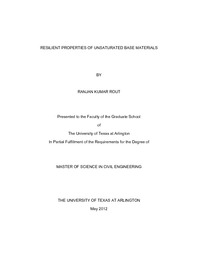
ATTENTION: The works hosted here are being migrated to a new repository that will consolidate resources, improve discoverability, and better show UTA's research impact on the global community. We will update authors as the migration progresses. Please see MavMatrix for more information.
Show simple item record
| dc.contributor.author | Rout, Ranjan Kumar | en_US |
| dc.date.accessioned | 2012-07-25T19:22:14Z | |
| dc.date.available | 2012-07-25T19:22:14Z | |
| dc.date.issued | 2012-07-25 | |
| dc.date.submitted | January 2012 | en_US |
| dc.identifier.other | DISS-11644 | en_US |
| dc.identifier.uri | http://hdl.handle.net/10106/11130 | |
| dc.description.abstract | A pavement system basically consists of a surface layer, a base course, a subbase (optional) and the subgrade. As per MEPDG and 1993 AASHTO flexible pavement design guide Resilient Modulus (MR) is used as the primary input parameter to determine the stiffness parameters and the constitutive behavior of pavement components, such as subgrade and unbound bases. Generally, pavements are constructed on compacted soils that are typically unsaturated with degrees of saturation varying from 75 to 90%. The main focus of this research is to determine the effect of matric suction on the resilient moduli property of the base materials. The second objective of the research is to study the use of MEPDG models to calibrate resilient moduli properties either as a function of moisture content or soil suction variables. In order to assess these objectives, these unbound materials were tested using suction controlled MR and moisture controlled MR procedures. Amendments were done by preparing the specimens at five different moisture content and dry density conditions. Suction controlled MR testing took longer time to reach the equilibrium conditions and the results obtained were close to the results obtained from moisture controlled MR procedure. The initial suction conditions are studied using Fredlund device (Tempe cell). Test results indicate that the specimens compacted on the dry side of the optimum have high resilient modulus due to the stress hardening behavior. MEPDG program procedure was followed to predict the soil water characteristic curve. Lastly, two three model parameter models developed by Cary and Zapata (2010) and Modified Universal model are studied and analyzed in detail. Validity of the correlation equations are addressed by comparing measured MR to predicted MR values. Results suggest that the models used are well suited for predicting the resilient modulus and soil water characteristic curve of the two unbound base materials | en_US |
| dc.description.sponsorship | Puppala, Anand | en_US |
| dc.language.iso | en | en_US |
| dc.publisher | Civil & Environmental Engineering | en_US |
| dc.title | Resilient Properties Of Unsaturated Base Materials | en_US |
| dc.type | M.S. | en_US |
| dc.contributor.committeeChair | Puppala, Anand | en_US |
| dc.degree.department | Civil & Environmental Engineering | en_US |
| dc.degree.discipline | Civil & Environmental Engineering | en_US |
| dc.degree.grantor | University of Texas at Arlington | en_US |
| dc.degree.level | masters | en_US |
| dc.degree.name | M.S. | en_US |
Files in this item
- Name:
- Rout_uta_2502M_11644.pdf
- Size:
- 1.467Mb
- Format:
- PDF
This item appears in the following Collection(s)
Show simple item record


